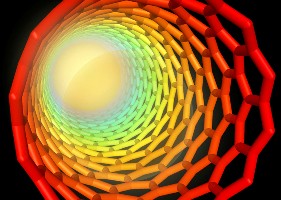Engineers at University of Missouri and U.S. Geological Survey in Columbia found carbon nanotubes — sub-microscopic structures increasingly used for their strength and conductivity to create innovative new materials — to be toxic to several species of aquatic animals. The research led by Baolin Deng, professor and chair of chemical engineering at Missouri, appears in the August issue of the journal Environmental Toxicology and Chemistry (paid subscription required).
Carbon nanotubes are extremely thin, hollow cylinders made of carbon atoms, with a diameter some 10,000 times smaller than a human hair. Because of their strength, electrical conductivity, and ability to combine with other metals, carbon nanotubes are used in a wide variety of composite materials in industries from medicine to electronics to construction.
Their sub-microscopic size and ability to easily combine with other substances also makes carbon nanotubes a potential hazard to organisms ingesting these materials. Deng and colleagues tested carbon nanotubes from commercial sources, in concentrations of one gram per liter of water, on four types of aquatic invertebrate organisms: mussels, larvae from small flies, worms, and crustaceans.
The researchers found carbon nanotubes in the water significantly reduced the survival or growth of all four organisms. Light and electron microscope imaging of the surviving test organisms found carbon nanotubes in the digestive systems as well as on the outer surface of the animals. However, the team found no evidence that the carbon nanotubes penetrated cell membranes.
The presence of metallic impurities in the nanotubes influenced their toxicity, say the researchers. Nickel, chromium, and other metals used in the nanotubes’ manufacturing processes can remain as impurities. Deng and colleagues found that these metals and the nanotubes themselves reduce the growth or even kill some aquatic species.
“The great promise of carbon nanotubes must be balanced with caution and preparation,” says Deng. “We don’t know enough about their effects on the environment and human health.” The research was funded by a $400,000 grant from the Environmental Protection Agency,
Read more:
- Scientists Produce Ultralight Carbon Nanotube Material
- Nanomaterials Registry Begun for Health, Environment Queries
- Boron Added to Carbon Nanotubes Produce Super Oil Sponge
- Aqueous Solution Tested to Reduce Carbon Nanotube Toxicity
- Toxicity to Human Cells of Nanotubes, Nanowires Investigated
* * *


 RSS - Posts
RSS - Posts
[…] Carbon Nanotubes Found Toxic to Aquatic Animals […]
[…] Carbon Nanotubes Found Toxic to Aquatic Animals […]